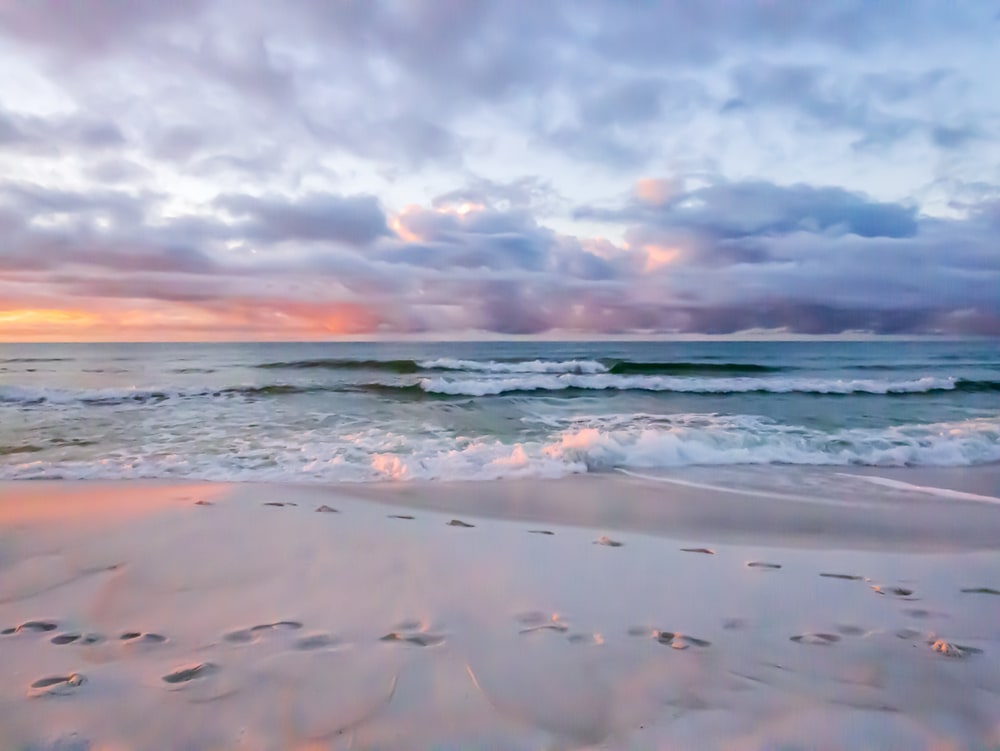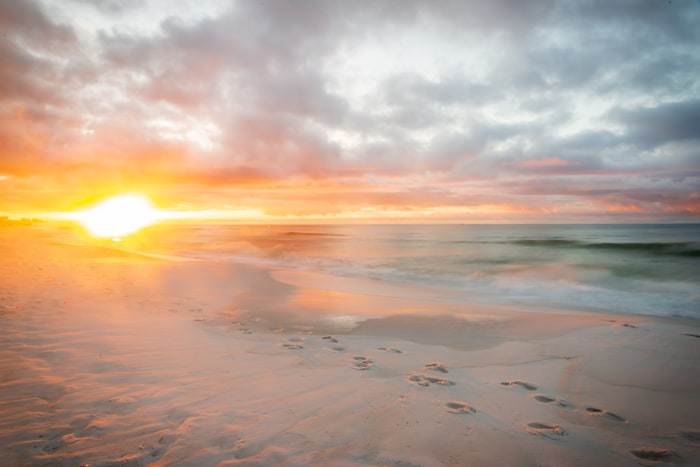Your shopping cart is empty.

Oct 28, 2020

I'm lucky to have such a good friend who invites me to Destin a couple of times a year. I was there in August but I spent the last few days down there as well.
We had some rain but also some beautiful days, and we got to spend some time with her lovely cousin, son, and DIL as well.
I’m excited about some of the photos I got.
Back in August when I went, I struggled with sunrise shots because the heat and humidity were so high that my camera fogged up, and I wasn't happy with many of the sunrise shots I got.
It was much cooler in Destin this time, so I was surprised I got some fogging on my lenses again, but thankfully this time it went away pretty fast and wasn't much of an issue.
I know I harp on this, so forgive me, but one of the many things I love about photography is how I can shoot the same subject over and over with completely different results.
Visual arts was half of my double major in college, and I studied a lot of art history.
I loved the Impressionists and now I know why.
The Impressionists, of which Monet is one of the most famous, painted many series of the same subject.
The reason? Because the light is always changing, so the painting is always different, even if it's the exact same subject.
His Haystacks series is a famous example. There are about 30 haystacks paintings all capturing the light at different times of the day. It was a great challenge for him.
I saw some of the Haystacks paintings at the Musée d"Orsay and the Musée de l'Orangerie in Paris many years ago. I was entranced with how the same subject looks so different depending on the lighting situation.
If you’re just starting out in photography, I encourage you to shoot as much as possible and don’t worry about attaining some sort of perfection in your shots.
Don't worry if you can't find a subject you're after.
Shoot what's in front of you and then shoot it again 15 minutes later and notice how the light changed and how that changes the feel of the composition.
While it’s always beneficial to work on the technical aspects of your photos, perfection is the enemy.
I've said it before, and I'll repeat it - as much for myself as for you - ditch perfection!
There’s no such thing anyway.
Some of the most emotionally evocative photos aren’t technically perfect, and that's okay.
You should know how to capture a scene using the best lighting and technique. But, you'll never learn if you don't give yourself some room for creativity and happy mistakes.
Remember the truth in President Theodore Roosevelt’s maxim: "comparison is the thief of joy."
There’s always someone whose photos you’ll admire, and you’ll wish your photos were like theirs.
It’s great to have goals and it’s instructive to try shooting in a style you admire. I do that all the time.
If you’ve followed me for a while, you know how much I love Brooke Shaden's work, and you can see some of her style in my composite shots.
I don’t want to shoot just like her, but learning how she works and edits has helped me to first emulate her and then to work toward doing things my own way.
Yes - master the basics first.
I’ve watched hundreds of hours of Photoshop tutorials from Brooke and many other photographers and artists. Once you master the basics, your style asserts itself.
There's always something to learn no matter what your subject is. Photography, painting, writing, physics - never stop learning.
Photography is a little like golf to me. Bear with me!
You can be an expert in golf - a professional - and still have terrible days on the golf course. You can be an amateur and have a great day where you’re playing almost outside yourself, above your “normal” level.
I’m a professional photographer. People pay for my prints, and they pay me to take photos of them.
But there are days when I feel completely off - nothing is coming out the “right” way or at least the way I think it should.
I have enough experience and knowledge that I can always get a decent shot when it’s called for, but I still make amateur mistakes now and then.
Then there are days when I’m over-the-moon happy with the shots I’m getting.
I can take photos every day from now until the day I die and I’m sure I’ll still be learning and figuring out new things.
There are some things you might not even think about that factor into your ability to get good shots - things like camera weight.
I’m selling my Sony a6000. It’s a great little camera, and it's super light but I couldn’t get used to it. It didn’t feel right in my hands.
Don't worry about what type of equipment your favorite photographer uses. Use what works best for you!
I picked up a used LUMIX that I brought with me to the beach. I also had my trusty Nikon.
I love my Nikon. I’ll never give that camera up.
But, I have struggled with the weight of the Nikon.
It's a big, heavy camera. I can't get a clear shot hand-holding it below 1/60th of a sec, and even 1/60th is sometimes not tack-sharp.
I’m left-handed, and the little fingers on my left hand go numb a lot. I think it’s all the years of sitting at the computer using a mouse.
Cameras are right-handed, so it’s not a camera issue per se but between the computer and camera, I have a lot of overuse of both hands.
The logical thing for me is to go mirrorless or micro-four-thirds so I’m not hauling a lot of heavy equipment around. It’s not only the camera body, it’s the lenses.
The wide-angle lens on my Nikon weighs a ton. It’s huge.
My back knows - I carried it with me for two weeks non-stop on my Cambodia trip. When I’ve got my Nikon and a couple of lenses, I’m hauling around a lot of weight.
For me, the LUMIX looks like it'll be a nice compromise. It’s a little bigger than the Sony with a more traditional hand grip I like, while still being much lighter than the Nikon.
As I said, I won't get rid of my Nikon, but I'll use the LUMIX more for traveling.
You have to use what works for you. Don't be afraid to pick up some used equipment to try it out. You can always sell it if it's not for you.
In Destin, when I went out for sunrise, I took the Nikon and LUMIX. I should have just taken the LUMIX to force myself to get used to it.
I wanted to take the Nikon, though, because I’ve got a 6-stop ND filter that I wanted to use so I could get “silky” water.

Beach sunrise photo was taken with Nikon with 6x ND filter
I got caught up with the Nikon and didn’t shoot with the LUMIX much, but I have to say I was thrilled when I saw the photos I got with the LUMIX.
I also liked what I got with the Nikon with the 6x ND filter.
You can see from the photo above that I was able to leave the shutter open long enough to capture movement in the water even though the sun was out and bright! It's tricky not blowing out your highlights when the sun is that bright.
That photo was taken at 1.6 sec at f/22, ISO 64, on a tripod. I used such a small aperture so I could leave the shutter open for more than a second without blowing the highlights.
You shouldn't look straight at the sun for the sake of your eyes, and don't point your camera's sensor right at the sun either. You can ruin the sensor.
The hardest part of any learning journey is sticking with it. I think social media has made a lot of people feel bad about their own efforts.
Don't fall for it.
Stick to your journey and don't worry about anyone else's. As my friend Mary always says, "Get your hands off my journey!"
It's good advice for all of us.
Your journey isn't a straight line, it's lots of twists, turns, ups, and downs. Just keep with it!
See you between the raindrops!
xoxo,
Susan
I've already put these two shots on the website here and here!
This is only visible to you because you are logged in and are authorized to manage this website. This message is not visible to other website visitors.
This means you can use the camera on your phone or tablet and superimpose any piece of art onto a wall inside of your home or business.
To use this feature, Just look for the "Live Preview AR" button when viewing any piece of art on this website!
This means you can use the camera on your phone or tablet and superimpose any piece of art onto a wall inside of your home or business.
To use this feature, Just look for the "Live Preview AR" button when viewing any piece of art on this website!

SAVE 15% ON YOUR FIRST ORDER!
Plus exclusive access to new releases and VIP discounts!
This offer is valid for NEW CUSTOMERS only!